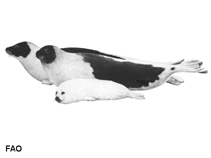| Family: |
Phocidae () |
| Max. size: |
190 cm TL (male/unsexed); 180 cm TL (female); max.weight: 135 kg; max.weight: 120 kg |
| Environment: |
bathydemersal; marine; depth range 0 - 6000 m |
| Distribution: |
Atlantic Ocean and the Arctic: North Atlantic Ocean, Arctic Ocean, Baffin Island, Magdalen Island, Russia, Canada (Ref. 1394). Pagophilus groenlandicus groenlandicus: Newfoundland, Jan Mayen (Norway), Baffin Bay, Greenland Sea, Nova Scotia, Greenland, Iceland; and vagrants in Virginia, Scotland, Germany, France; Pagophilus groenlandicus oceanicus: Barents Sea, Russia, White Sea (Ref. 1522). |
| Diagnosis: |
|
| Biology: |
Live chiefly in pack ice, but can be found away from it in summer. Feeds on a variety of crustaceans and open-water fishes during migration, and switch to several varieties of bottom dwelling fishes in summer on the northern grounds (Ref. 1394). Live chiefly in pack ice, but can be found away from it in summer (Ref. 1394). Adults are highly gregarious; young seals tend to be solitary. Typically forms aggregations when feeding (Ref. 117964). Feeds on a variety of crustaceans and open-water fishes during migration, and switch to several varieties of bottom dwelling fishes in summer on the northern grounds (Ref. 1394). |
| IUCN Red List Status: |
(LC); Date assessed: 06 June 2015 Ref. 123251)
|
| Threat to humans: |
|
| Country info: |
|
Source and more info: www.sealifebase.org. For personal, classroom, and other internal use only. Not for publication.

